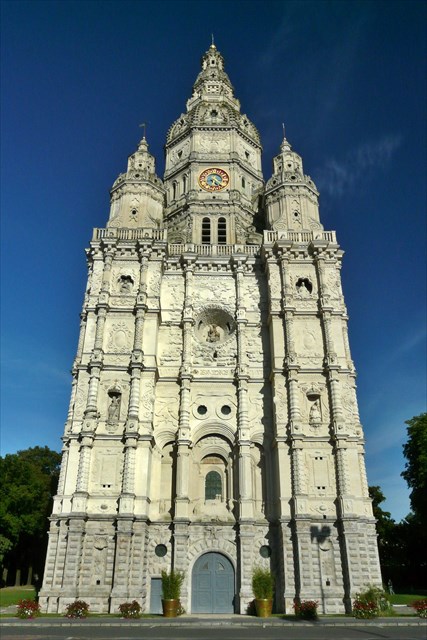[GN16] La Tour Abbatiale de Saint-Amand-les-Eaux EarthCache
[GN16] La Tour Abbatiale de Saint-Amand-les-Eaux
-
Difficulty:
-

-
Terrain:
-

Size:  (other)
(other)
Please note Use of geocaching.com services is subject to the terms and conditions
in our disclaimer.
![]() FRANCAIS
FRANCAIS
La Tour de l'ancienne abbaye bénédictine, haute de 82 m, est le monument le plus imposant de la ville de Saint-Amand-les-Eaux.
 Face occidentale de la Tour Abbatiale de Saint-Amand-les-Eaux
Face occidentale de la Tour Abbatiale de Saint-Amand-les-Eaux
Elle est presque entièrement construite en Pierre d'Avesnes-le-Sec, du nom d'une petite commune située entre Valenciennes et Cambrai où cette roche fut extraite pendant des siècles. La Pierre d’Avesnes-le-Sec, qui rend la Tour Abbatiale si blanche sous le soleil, est une craie, formée de squelettes de micro organismes marins qui se sont accumulés au Turonien, il y a environ 90 millions d'années (Crétacé supérieur). Cette roche, bien que perméable, était appréciée des bâtisseurs car elle est facile à tailler et à sculpter.
Seule la base de la Tour est d'aspect différent, car elle a été réalisée en grès de teintes variées. La forte résistance mécanique du grès, formé de grains de sables cimentés, en fait un matériau privilégié pour construire les soubassements des batiments. De plus, la faible porosité de cette roche évite les remontées d'humidité par capillarité dans les blocs de craie des parties hautes. Néanmoins, le grès étant difficile à travailler, la décoration des murs extérieurs du rez-de-chaussée se révèle plus rustique que celle des étages.
Les coordonnées vous conduiront au pied de la Tour Abbatiale. Comme pour toutes les earthcaches, l’objectif n’est pas de découvrir une boîte.
Pour valider votre visite, il vous suffit de répondre aux questions suivantes :
1- Pour quelles raisons le grès a t'il été préféré à la Pierre d'Avesne-le-Sec pour construire la base de la Tour Abbatiale ?
2- Sur la face méridionale de la Tour, identifiez sur le pilier les roches A, B et C, masquées sur la photo ci-dessous, et décrivez leurs couleurs respectives.

3- Quelques mètres à gauche du pilier, vous remarquerez un gros coquillage. S'agit il d'un fossile ?
Après avoir examiné la Tour Abbatiale, loguez cette earthcache "Found it" et envoyez-moi vos propositions de réponses soit via mon profil, soit via le Message Center. Je vous contacterai en cas de problème. |
ENGLISH
The Tower of the former Benedictine abbey, high of 82 m, is the most imposing monument of the city of Saint-Amand-les-Eaux.
 Western frontage of the Abbey Tower of Saint-Amand-les-Eaux
Western frontage of the Abbey Tower of Saint-Amand-les-EauxIt is almost entirely built in stone of Avesnes-le-Sec, the name of a small town located between Valenciennes and Cambrai where this rock was extracted for centuries. The Stone of Avesnes-le-Sec, which makes the Tower Abbey so white under the sun, is a chalk, it consists of skeletons of micro marine organisms accumulated in the Turonian, there are about 90 million years (Cretaceous superior). This rock, although permeable, was popular with builders because it is easy to carve and sculpt.
Only the base of the tower is different, it was made in different sandstone types and colours. The high mechanical strength of sandstone, formed of cemented sand grains, makes it an ideal material for building the foundations of buildings. In addition, the low porosity of the rock prevents moisture rising damp in chalk blocks of the upper parts. Nevertheless, sandstone being difficult to work, the decoration of the outside walls of the ground floor is more rustic than the other floors.
The coordinates will take you to the Fontaine des chommeurs (Fountain of Unemployed). As with all Earthcaches, the goal is not to find a box.
The observation of this source and the above description will help you validate this earthcache by answering the following questions:
1- Why sandstone has been preferred to the Avesne le Sec rock to build the base of the Abbey Tower?
2- On the southern front of the Tower, identify rocks on the pillar A, B and C, hidden in the picture below, and describe their respective colors.

3- A few meters to the left of the pillar, you will find a big shell. Is it a fossil?
After visiting the site of the abbatiale tour, log this earthcache "Found it" and send me your answers proposals either via my profile or via the Message Center. I will contact you in case of problem.
|
Additional Hints
(No hints available.)